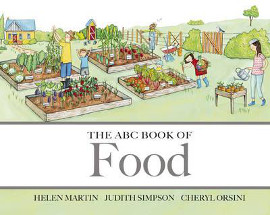The ABC book of food by Helen Martin and Judith Simpson

Ill. by Cheryl Orsini. ABC Books, 2016. ISBN 9780733334269
Just as cars and trains and boats and planes need fuel to keep them
going, so do our bodies. But while vehicles need only one sort of
fuel, our bodies operate best on a variety of foods from a variety
of sources so that all its myriad parts can operate with maximum
efficiency. Many young children, particularly those who live in the
cities, go to the supermarket with their parents and carers and see
their food being bought but they don't often realise how it has got
to be on the shelves in the first place.
This story-in-rhyme helps to explain the process and the journey
from paddock to plate of some of the more common foods the children
eat. Starting with breakfast where eggs and milk are tracked,
different staples for each meal are investigated in a series of
clear vignettes that helps the very young child understand the
connection between what they eat and where it comes from.
Using familiar scenes such as the breakfast table, a picnic and a
family dinner there are many foods on display and while only a
couple are featured in the explanations, there is plenty of scope to
consider where others might come from. If the bananas start on
plants, what other foods in the pictures might come from plants?
Would they have a similar journey? What about the cupcakes or the
sausages?
There is also a page devoted to the common foods that some people
cannot eat which makes food intolerances more 'mainstream' and
perhaps better understood.
This book is an opportunity to start children thinking about
what they eat, what the best choices might be, sorting them into
food groups, identifying and graphing not only their favourites but
also mapping what they eat each day and maybe changing the
proportions if their pie graph is a bit skewed. It might even be the
beginning of the child's desire to produce their own food either in
a home or school garden as well as introducing plant life cycles and the
notion of seasonal produce. Even sharing recipes and following
instructions to make them could be a popular activity - all adding
to their understanding and interpretation of information.
This is the latest in this series of excellent titles which helps
our very young children begin to understand the world around them as
well as helping them understand the differences between fiction and
non fiction.
Barbara Braxton